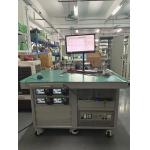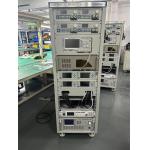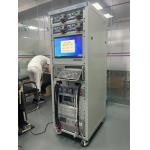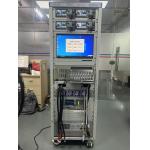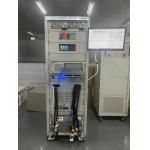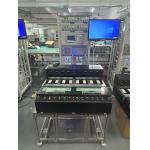Test equipment QC/PD Charger Intelligent Power Test
Comprehensive System ATE Comprehensive Tester Twenty Years of
Manufacturer Experience The application areas of the power automatic test system are as
follows: 1. Power Supply Manufacturing- Product Performance Testing: During the production process of power supplies, it can
accurately and quickly measure various performance indicators such
as output voltage, current, power, and conversion efficiency. For
example, in the mass production of switching power supplies, the
system can automatically test whether each power supply meets the
rated voltage requirements, ensuring consistent product
performance.
- Quality Control: It helps monitor the quality of power supplies by conducting
multiple tests, including load regulation, line regulation, and
ripple coefficient tests. This ensures that only high-quality power
supplies that meet the specified standards are delivered to
customers, reducing the probability of defective products leaving
the factory.
- Research and Development Assistance: In the research and development stage of new power supplies, it
provides engineers with detailed parameter measurement and analysis
functions. Engineers can use it to test the performance of new
circuit topologies, component selections, and control algorithms,
thereby accelerating the research and development cycle and
optimizing product design.
2. Power Grid System- Substation Testing: In substations, it is used to test various electrical equipment
such as transformers, circuit breakers, and relays. For example, it
can test the insulation resistance, withstand voltage, and
operating characteristics of transformers to ensure the safe
operation of the equipment and the stability of the power grid.
- Power Line Maintenance: When maintaining power lines, it can be used to check the
insulation performance and fault location of power lines. It helps
maintenance personnel quickly find potential fault points on the
lines, such as insulation aging or damage, and take timely repair
measures to improve the reliability of power supply.
- Solar and Wind Power Generation Systems: With the rapid development of renewable energy, it plays an
important role in solar and wind power generation systems. It can
test the output characteristics, efficiency, and grid connection
performance of photovoltaic inverters and wind turbine generators,
ensuring the efficient conversion and stable grid connection of
renewable energy.
3. Electrical Appliance Industry- Appliance Safety Compliance Testing: For household appliances such as refrigerators, washing machines,
air conditioners, etc., it tests the ground insulation resistance,
leakage current, and dielectric strength of the power modules of
the appliances to ensure that they meet relevant safety standards
and do not pose a risk of electric shock or electrical fire to
users.
- Performance Testing: It can also be used to test the power consumption, motor
performance, and control system response speed of appliances. For
example, in the production of air conditioners, it can test the
startup current, operating current, and refrigeration effect of the
air conditioner under different working conditions to evaluate the
performance of the appliance and provide data support for
optimizing product design.
4. Automotive Industry- Vehicle Battery Testing: In automotive manufacturing and maintenance, it is used to test
the state of health (SOH), charging and discharging performance,
and internal resistance of vehicle batteries. This helps determine
whether the battery needs to be replaced and ensures the reliable
starting and power supply of the vehicle.
- Electric Vehicle Charging Facility Testing: With the popularization of electric vehicles, it is used to test
the performance of electric vehicle charging piles. It can test the
output voltage accuracy, current stability, communication protocol
compatibility, etc. of the charging piles to ensure the safe and
efficient charging of electric vehicles.
- On-board Power System Testing: For electric vehicles, it can also be used to test the
performance of on-board power systems such as DC-DC converters and
electric drive systems. It ensures the stability and efficiency of
the power systems within the vehicle, improving the driving range
and performance of the electric vehicle.
5. Aerospace and Defense Industry- Avionics Equipment Testing: In the aerospace field, it is used for testing avionics equipment
such as flight control systems, avionics instruments, and
communication systems. It ensures that these critical equipment
have stable and reliable power supply performance under various
complex working conditions, preventing power problems from
affecting flight safety.
- Weapon System Power Testing: In the defense industry, it tests the power modules of weapons
such as missile launch systems, radar systems, and communication
command systems. It ensures that the weapons have sufficient and
stable power supply during use, guaranteeing their performance and
combat effectiveness.
- Aerospace Launch System Testing: For rocket launch systems, it tests the power systems of rocket
launch vehicles, including battery groups, power converters, etc.
It ensures that these power systems can provide stable power
support during launch preparation and flight processes,
guaranteeing the success of launch missions.
Top-Smart 2000 ATE Power Supply Testing System Test Items: | Test items | Comprehensive Test items | | CEC test | Short circuit test | | DC Current under C.V.Mode | Short circuit current | | Peak-Peak noise | OV protection | | Serial reaction time test | UV protection | | Transient response time | OL protection | | Transient spike | OP protection | | Tracking | In-test adjustment test | | Voltage regulation | AC cycle drop out | | Current regulation | PLD simulation | | Turn ON time | DC output current test | | Rise time | DC output voltage test | | Fall time | Waveform read test | | Hold-up time | Input impulse current test | | Inrush current test | Input power | | Power good signal | Relay control | | Power fail signal | Bar code scan | | P/S ON signal | Dynamic test | | Power up sequence | Specification under C.P.Mode | | Power off sequence | Input Peak current | | Effciency test | Additional expansion measurement test | | Overall stability test | Input RMS current | | Fan Speed test | TTL signal control | | Input power factor | LAN read/write | | Input voltage ramp | RS485 read/write | | Input freq. ramp | USB read/write | | Extend the measurement test | 232 read/write | | Automatic test | GPIB read/write |
|
